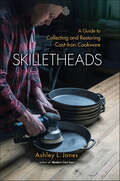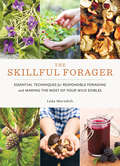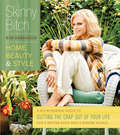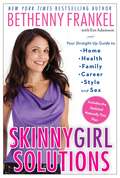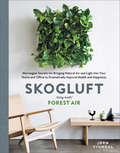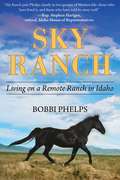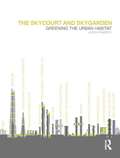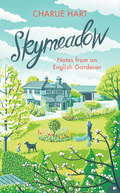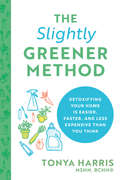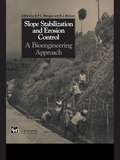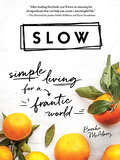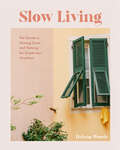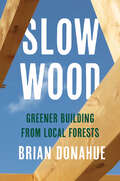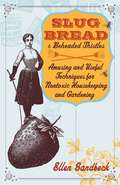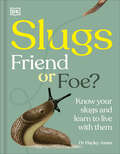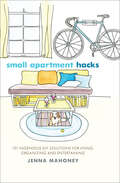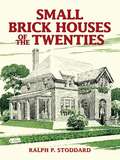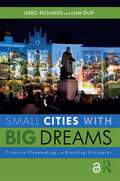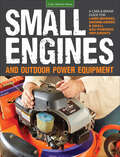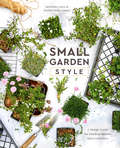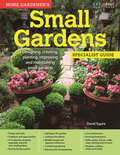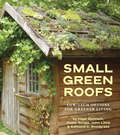- Table View
- List View
Skilletheads: A Guide to Collecting and Restoring Cast-Iron Cookware
by Ashley L. JonesPart science and part personal preference, collecting and restoring cast-iron cookware is a complex art. For instance, what makes each company's cast iron unique? Do chemicals used during restoration leach into food? When it comes to surface finish, is textured or smooth better?In Skilletheads, the highly anticipated follow-up to Modern Cast Iron, Ashley L. Jones dives deeper than ever into the world of cast iron. In these pages, which feature over 100 full-color photos, you'll find expert advice on purchasing cast iron from some of the most active collectors in the field today; side-by-side comparisons of the major manufacturers in the US and interviews with each company; and detailed how-to guides for restoring cast iron, including such methods as lye baths, electrolysis tanks, and chemical products, all compiled with input from devoted Skilletheads. And because no book on cast iron is complete without a little cooking, Jones includes 35 mouth-watering recipes contributed by foodies who know cast iron best—everything from Sunday Frittata to Braised Chicken to Skillet S'mores.Whether you're interested in finding the perfect pan for your kitchen or starting a new hobby restoring cast iron, Skilletheads is here to help.
The Skillful Forager: Essential Techniques for Responsible Foraging and Making the Most of Your Wild Edibles
by Leda MeredithThe Skillful Forager is the ultimate forager’s guide to working with any wild plant in the field, kitchen, or pantry. From harvesting skills that will allow you to gather from the same plant again and again to highlighting how to get the most out of each and every type of wild edible, trusted expert Leda Meredith explores the most effective ways to harvest, preserve, and prepare all of your foraged foods. Featuring detailed identification information for over forty wild edibles commonly found across North America, the plant profiles in this book focus on sustainable harvesting techniques that can be applied to hundreds of other plants. This indispensable reference also provides simple recipes that can help you make the most of your harvest each season.
Skills for Personal and Family Living
by Frances Baynor Parnell Joyce Honeycutt WootenComprehensive Family and Consumer Sciences text helps secondary level students meet the challenges of their daily lives with confidence. It will help you develop a range of skills related to interpersonal and family relationships, getting and keeping a job, management, healthy living, foods and nutrition, clothing, and housing.
Skinny Bitch: A No-Nonsense Guide to Cutting the Crap Out of Your Life for a Better Body and a Kinder World
by Kim BarnouinKim Barnouin has already told her fans how to “stop eating crap and start looking fabulous.” But there’s more to being a Skinny Bitch than eating well.<P><P> Turns out, there’s crap everywhere—not just in food, but in cosmetics, clothing, and home furnishings. Kim blows the lid on all of the nasties in our everyday stuff (everything from lipstick to sofa upholstery), and shows how we can make both small and big changes in our home, wardrobe, and beauty regimen—for living the Ultimate Skinny Bitch lifestyle!
Skinnygirl Solutions: Your Straight-Up Guide to Home, Health, Family, Career, Style, and Sex
by Bethenny FrankelBethenny Frankel, four-time New York Times bestselling author, on-the-go working mom, self-made businesswoman, and daytime’s newest talk show host, shares her Skinnygirl guide to life: simple ideas, extraordinary results.YOUR GUIDE TO HAVING IT ALL WITHOUT GE TTING OVERWHELMED In Skinnygirl Solutions, New York Times bestselling author Bethenny Frankel offers her best tips on home, health, family, career, style, and, of course, sex. Her no-nonsense advice extends beyond the first adult steps and well into real relationships, established careers, and mommyhood. Skinnygirl Solutions offers many practical tips on how to lead a well-balanced life, including: • Living Naturally Thin • Making fresh, healthy food for the table and on the go • Organizing your kitchen, your closet, and even your bathroom • Finding great fashion without breaking the bank • Beauty care essentials • Creating a home that’s a haven • Effortless entertaining • Career planning • Entrepreneurial advice
Skogluft: Norwegian Secrets for Bringing Natural Air and Light into Your Home and Office to Dramatically Improve Health and Happiness
by Jorn ViumdalThe simple, easy to understand Norwegian method for bringing nature into your home and office to help your health and mood.For millions of years, humans developed in natural environments, in close contact with sunlight, vegetation, water, and air. While we are biologically and physiologically similar to our Stone Age ancestors, most of us spend nearly all of our lives indoors, removed from the natural world. Studies have shown that spending time outdoors in or near nature delivers emotional, psychological, and physical benefits. Jorn Viumdal is on a mission to bring a natural living environment back to the home and workplace. In Skogluft—which translates to” forest air”—he draws on data from the University of Environmental Research and Bioscience in Norway and three decades of NASA research to reveal how a carefully chosen selection of plants grown and placed in a specific way indoors can dramatically improve health, reduce fatigue, strengthen the immune system, and enhance concentration, communication, and vitality. Having these plants around us can help improve how our bodies feel and prevent disease, make us happier and calmer, and increase our efficiency and productivity.Skogluft teaches you how to transform any wall in a home or office into a living wall to help remove toxins from the air, reduce stress, and strengthen the immune system. Viumdal explains which plants improve overall health and release different gases for optimal well-being. All the vegetation can be found in local nurseries or stores and online. Following Viumdal’s method, you will feel better, have more energy, and lift your spirits as you add natural beauty into your world.
Skoolie!: How to Convert a School Bus or Van into a Tiny Home or Recreational Vehicle
by Will SutherlandSchool buses that have been converted into mobile living spaces — known as skoolies — are a natural extension of the tiny house craze. Buses are not only easier and safer to drive than an RV, they provide a jump-start on the conversion process with frame, roof, and floor already in place. Experienced builder Will Sutherland, whose creative school bus conversions have been featured in Road and Track and Popular Mechanics, is behind the wheel of this alluring look at life on the road. In addition to profiles of eight fellow skoolie fans and stunning photos of bus interiors designed for simple living, Skoolie! does what no other book on the subject has — it offers a complete, step-by-step guide to the conversion process, from seat removal to planning layout and installing insulation, flooring, and furnishings that meet your needs. This publication conforms to the EPUB Accessibility specification at WCAG 2.0 Level AA.
Sky Ranch: Living on a Remote Ranch in Idaho
by Bobbi PhelpsA city girl is uprooted and moved to the farm, where she must overcome her fears and learn to live life in a rougher way. Once Bobbi Phelps married an Idaho rancher, she discovered what it was like to live in rural America. The contrast between her suburban background and her farming life created challenging yet rewarding differences. Sky Ranch tells of Bobbi Phelps’s Idaho ranch experiences between 1980 and 1996, the adventures in a past time before camera phones, GPS technology, and social media. Throughout this memoir, she shares frightening tales of: - Dangerous white-outs during Rocky Mountain blizzards. - A terrifying flooded road crossing in pitch blackness. - A near drowning while fishing Henry’s Lake. - Losing her young son among huge harvesting machines. Sky Ranch is a memoir about a naïve suburban woman who struggled to navigate an industrial farm and its commercial cattle enterprise. Her life on the ranch meant grocery shopping once every two weeks, driving through harsh winter storms and swollen streams, and rescuing her horse in a full-blown blizzard. Living in the Rocky Mountains allowed her to fish, hunt, and camp on a regular basis. She also discovered different aspects of the Mormon religion, coyotes hunting her dog, industrial farming, and environmental conservation. Sky Ranch will appeal to readers interested in Western culture, cattle and row-crop farmers, hunters, anglers, and those who only dream of living on a ranch. It takes the reader on an exciting ride of terror, drama, and humor, giving us a look at what goes on behind the scenes at a rural ranch, many miles from civilization.
The Skycourt and Skygarden: Greening the urban habitat
by Jason PomeroyPopulation increases, advances in technology and the continued trend towards inner-city migration have transformed the traditional city of spaces into the modern city of objects. This has necessitated alternative spatial and technological solutions to replenish those environments that were once so intrinsic to society’s day-to-day interactions and communal activities. This book considers skycourts and skygardens as ‘alternative social spaces’ that form part of a broader multi-level urban infrastructure – seeking to make good the loss of open space within the built environment. Jason Pomeroy begins the discussion with the decline of the public realm, and how the semi-public realm has been incorporated into a spatial hierarchy that supports the primary figurative spaces on the ground or, in their absence, creates them in the sky. He then considers skycourts and skygardens in terms of the social, cultural, economic, environmental, technological and spatial benefits that they provide to the urban habitat. Pomeroy concludes by advocating a new hybrid that can harness the social characteristics of the public domain, but be placed within buildings as an alternative communal space for the 21st century. Using graphics and full colour images throughout, the author explores 40 current and forthcoming skycourt and skygarden projects from around the world, including the Shard (London), Marina Bay Sands (Singapore), the Shanghai Tower (China) and the Lotte Tower (South Korea).
Skymeadow: Notes from an English Gardener
by Charlie Hart'A love letter to English horticulture written by a passionate gardener. A must-read for anyone who has dreamt of cultivating their own patch of land' Jane Perrone'Skymeadow is a fascinating book . . . Every flower, every passing bud, every change in the season is described with rapture' Jilly CooperWhen Charlie Hart first visited Peverels, a small farmhouse that sits lazily on the lip of a hill running down into the Peb Valley, he was at breaking point, grieving the loss of his father and anxious about the impending death of his mother. He and his wife Sybilla felt that their London life had been steadily growing in noise: the noise of grief, the noise of busyness, the noise that comes from the expectations of others and, for Charlie, the constant clamour of dissatisfaction at work. At Peverels, Charlie found an expanse of untouched meadowland, the perfect setting for an audacious garden. Charlie felt an unquenchable urge to dig, to create something. The days he spent wrestling with the soil in the rose garden were the days in which he mourned the loss of his parents. Gardening has taught him that you can dig for victory, but you can also dig for mental health. As the garden formed around Charlie, he buried his fears and anxieties within it. A garden that is now known as Skymeadow and grows with a lusty, almost biblical vigour.In Skymeadow, Charlie seamlessly weaves together his own memoir with that of his garden. The result is a lyrical and incisive story of mental health at an all-time low, the healing powers of digging and, ultimately, a celebration of nature.
Skymeadow: Notes from an English Gardener
by Charlie Hart'A love letter to English horticulture written by a passionate gardener. A must-read for anyone who has dreamt of cultivating their own patch of land' Jane Perrone'Skymeadow is a fascinating book . . . Every flower, every passing bud, every change in the season is described with rapture' Jilly CooperWhen Charlie Hart first visited Peverels, a small farmhouse that sits lazily on the lip of a hill running down into the Peb Valley, he was at breaking point, grieving the loss of his father and anxious about the impending death of his mother. He and his wife Sybilla felt that their London life had been steadily growing in noise: the noise of grief, the noise of busyness, the noise that comes from the expectations of others and, for Charlie, the constant clamour of dissatisfaction at work. At Peverels, Charlie found an expanse of untouched meadowland, the perfect setting for an audacious garden. Charlie felt an unquenchable urge to dig, to create something. The days he spent wrestling with the soil in the rose garden were the days in which he mourned the loss of his parents. Gardening has taught him that you can dig for victory, but you can also dig for mental health. As the garden formed around Charlie, he buried his fears and anxieties within it. A garden that is now known as Skymeadow and grows with a lusty, almost biblical vigour.In Skymeadow, Charlie seamlessly weaves together his own memoir with that of his garden. The result is a lyrical and incisive story of mental health at an all-time low, the healing powers of digging and, ultimately, a celebration of nature.
The Slightly Greener Method: Detoxifying Your Home Is Easier, Faster, and Less Expensive than You Think
by Tonya HarrisFrom the foods you consume to the household and personal care products you buy, being just slightly greener can have a big impact on your health and happiness!The Slightly Greener Method gives you small, actionable changes you can easily make in three areas of your home—the kitchen (foods and beverages), bathroom (personal care products and cosmetics), and cleaning products—without breaking the bank or upending your life.You don't have to be 100% chemical free to be healthier and safer. By focusing on micro-habits you can build over time and the gradual introduction of non-toxic, all-natural or organic, eco-friendly products, board-certified holistic nutritionist Tonya Harris guides you along a roadmap to a greener, more environmentally-friendly and sustainable lifestyle that can help protect you and your families' health long-term.Get answers to questions like:What does "organic" really mean?Which of the unpronounceable chemicals listed on the back of my shampoo bottle might be toxic?Do I really need to throw away expired makeup?Why aren't companies always required to list toxic ingredients on their product labels?How can I make sure my kids and pets are safe while also keeping a squeaky clean house?It's never too soon (or too late) to start your slightly greener journey! This practical, actionable guide is perfect for readers of bestselling lifestyle and organizational books such as The Complete Book of Clean and Zero Waste Home, and fans of TV shows like Tidying Up with Marie Kondo and The Home Edit.
Slope Stabilization and Erosion Control: A Bioengineering Approach
by Roy P.C. Morgan R.J. RicksonThis book is an up-to-date review of research and practice on the use of vegetation for slope stabilization and control of surface erosion caused by water and wind. From a basic understanding of the principles and practices of vegetation growth and establishment, it describes how vegetation can be treated as an engineering material and used to solve erosion and slope stability problems.
Slow: Simple Living for a Frantic World
by Brooke McAlaryFree yourself from the frantic and embrace the joy of slow..."After reading this book, you'll have an amazing list of ingredients that can help you create a meaningful life, too!" —The Minimalists Joshua Fields Millburn and Ryan Nicodemus"Finally, a slow living guide for the imperfect folks . . . Brooke McAlary's exuberant, honest words are a refreshing contribution to the slow living community. If you're seeking a simpler path, start here." —Erin Loechner, Blogger at DesignforMankind.com and author of Chasing SlowAre you constantly striving to keep up with life's busy expectations? It's easy to feel consumed with the desire to "succeed" and "acquire", and miss the simple opportunities waiting for you to slow down: a walk in the forest, sharing laughter with family, a personal moment of gratitude...Once upon a time, it became clear to Brooke McAlary that the key to happiness was discovering a simpler, more fulfilling existence. She put the brakes on her stressful path, and reorganized her life to live outside the status-quo, emphasizing depth, connection and meaningful experiences. Alongside Brooke's affirming personal stories of breaking down and rising up, Slow provides practical advice and fascinating insights into the benefits and challenges of the slow life, such as: —Decluttering to de-owning—Messiness to mindfulness—Asking why, to asking where to now?Slow is an inspirational guide on creating a life filled with the things that really matter, and is meant for anyone seeking peace, meaning, and joy in their otherwise rapid lives. Slowly—of course.
Slow Living: The Secrets to Slowing Down and Noticing the Simple Joys Anywhere
by Helena WoodsMake Slow Living Part of Your Everyday!“Slow Living is a work of art…I observed a sense of calm within myself as I read its pages and appreciated the beautiful pictures.” —Andrea Henkels, author of Herman Heals His HeartLiving peacefully is within reach if you slow down your life. With Slow Living, you too can embrace simple living and mindfulness for peace-induced days!Looking for peace and happiness? Book a personal reading hour with Slow Living, your guide on how to slow down your life and live peacefully. Helena Woods, author and creator of popular YouTube channel Simple Joys, reveals the wisdom she has learned by moving abroad from the US and living a slower life in France. With beautiful prose and original photography, she provides inspiration and guidance to create a simple living environment wherever you are.Slow Living is for anyone looking to simplify life. Personal growth books for women tend to leave out men and children, but this book was intentionally crafted with everyone in mind! If you're looking for how to improve yourself and how to get into simple living, then this is the guide for you! For many, a slow European lifestyle seems out of reach, but with the direction in this book, readers are able to craft this lifestyle for themselves anywhere, anytime.Inside, you’ll find:Ways to value quiet moments, which bring simple joys to your lifeHow slow living takes root when less becomes more in your homeA guide on how to simplify your everyday life for mental clarityHow to create routines that enrich your mind and feed your soulIf you like books for homebodies or if you enjoyed Slow, Essentialism, or Simple Pleasures, you’ll love Slow Living.
Slow Wood: Greener Building from Local Forests (Yale Agrarian Studies Series)
by Brian DonahueA radical proposal for healing the relationship between humans and forests through responsible, sustainable use of local and regional wood in home building American homes are typically made of lumber and plywood delivered by a global system of ruthless extraction, or of concrete and steel, which are even worse for the planet. Wood is often the most sustainable material for building, but we need to protect diverse forests as much as we desperately need more houses. Brian Donahue addresses this modern conundrum by documenting his experiences building a timber frame home from the wood growing on his family farm, practicing &“worst first&” forestry. Through the stories of the trees he used (sugar maple, black cherry, black birch, and hemlock), and some he didn&’t (white pine and red oak), the book also explores the history of Americans&’ relationship with their forests. Donahue provides a new interpretation of the connection between American houses and local woodlands. He delves into how this bond was broken by the rise of a market economy of industrial resource extraction and addresses the challenge of restoring a more enduring relationship. Ultimately, this book provides a blueprint and a stewardship plan for how to live more responsibly with the woods, offering a sustainable approach to both forestry and building centered on tightly connected ecological and social values.
Slug Bread and Beheaded Thistles: Amusing and Useful Techniques for Nontoxic Housekeeping and Gardening
by Ellen SandbeckOff with their heads! Many homemakers and gardeners take the easy way out when it comes to exiling odors and banishing bugs--they use toxic chemicals that may be harmful to their families and the earth. Ellen Sandbeck has discovered that the all-natural alternatives are just as easy and effective to use, and that they are wickedly fun. Sandbeck's way of banishing thistles from her backyard kingdom is a case in point: she chops off their heads and lets them bleed to death. Slug Bread & Beheaded Thistlesreveals all of her best tricks. From bedroom to bathroom, garden to lawn, your home will be clean and green and pest-free. Explode cockroaches with baking soda and sugar Freshen your car with coffee grounds Keep out slugs with a bread dough that kills Armor your plants with soap spray Grow disease-resistant plants by putting sick ones in your compost pile Eradicate crayon marks with mayonnaise Protect your roses with a minefield of garlic Get rid of raccoons with dirty laundry Cure plant viruses with spoiled milk
Slugs: Know Your Slugs and Learn to Live with Them
by Royal Horticultural SocietyAre slugs and snails wreaking havoc in your garden? Do you want to nip the problem in the bud but don't know how without resorting to harmful pesticides?Every gardener shares the same struggle. But what if not all slugs deserve the bad rap in your garden?Discover everything you need to know about slugs: the different species, their fascinating life cycles, and the important role they play in your garden ecosystem. Learn which slugs are busy recycling decaying matter and which ones have your precious seedling firmly on their menus, as well as the practical steps you can take to control them with eco-friendly measures.Think you know slugs? Think again. Let the experts help you become friends with mollusks with Slugs: Friend or Foe?
Small Apartment Hacks: 101 Ingenious DIY Solutions for Living, Organizing and Entertaining
by Jenna MahoneyHelpful tips, space-saving tricks, and DIY projects to help make a shoebox apartment beautifully functional. This handy guide enables readers to transform their tiny, shoebox apartment into a welcoming, delightful and adorable abode. The author&’s advice gives anyone the chance to have a stylish, space-savvy home by showing how to take advantage of every nook and cranny. Whether it&’s maximizing floor space with furniture arrangements like a lofted bed above a work area or inventive storage solutions like a dining table that stashes dishes, there is no space too small to be made posh by Small Apartment Hacks. LIVE LARGE • Hang hobby clutter like guitars or bikes on the wall as decoration • Mount side tables on wheels for easy rolling from bedside to sofa ORGANIZE SMART • Upcycle empty wine crates into stylish, stackable shoe cubbies • Line a room with high bookshelves for a ceiling-top library ENTERTAIN IN STYLE • Utilize kitchen space to make an impressive entrée—go potluck on the sides • Stash plants, lamps, and coffee tables in the bathtub to open up party space&“Heed Jenna Mahoney&’s advice. In her new book, Small Apartment Hacks, she dishes out genius ideas for optimizing tiny spaces.&” —Daily Candy
Small Brick Houses of the Twenties
by Ralph P. StoddardOnce affordable only among the wealthy, brick homes became more easily available to the average American in the early years of the twentieth century. This book, originally published in 1920 by a member of The Common Brick Manufacturers' Association, served as a practical guide for prospective homeowners from working class families. Many soon found that attractive, durable, and comfortable homes--made from nature's own building material--were easily within their financial reach. <p><p> Thirty-five sets of floor plans, elevations, and specifications in this excellent reproduction of that now-rare volume depict a wide variety of brick houses, bungalows, cottages, garages, and multi-dwelling buildings--from the four-bedroom Pocatello to the handsome Saratoga, featuring a wraparound porch and two bathrooms. This practical guide will appeal to anyone wanting to buy or renovate an existing home of the period. It will also serve as a how-to manual for all desiring to build their own homes today with authentic materials and techniques. For those who love fine, old buildings, Small Brick Houses of the Twenties offers a charming view of American homes from that era.
Small Cities with Big Dreams: Creative Placemaking and Branding Strategies
by Greg Richards Lian DuifHow can small cities make an impact in a globalizing world dominated by ‘world cities’ and urban development strategies aimed at increasing agglomeration? This book addresses the challenges of smaller cities trying to put themselves on the map, attract resources and initiate development. Placemaking has become an important tool for driving urban development that is sensitive to the needs of communities. This volume examines the development of creative placemaking practices that can help to link small cities to external networks, stimulate collaboration and help them make the most of the opportunities presented by the knowledge economy. The authors argue that the adoption of more strategic, holistic placemaking strategies that engage all stakeholders can be a successful alternative to copying bigger places. Drawing on a range of examples from around the world, they analyse small city development strategies and identify key success factors. This book focuses on the case of ‘s-Hertogenbosch, a small Dutch city that used cultural programming to link itself to global networks and stimulate economic, cultural, social and creative development. It advocates the use of cultural programming strategies as a more flexible alternative to traditional top-down planning approaches and as a means of avoiding copying the big city. The Open Access version of this book, available at http://www.taylorfrancis.com, has been made available under a Creative Commons Attribution-Non Commercial-No Derivatives (CC-BY-NC-ND) 4.0 license.
Small Engines and Outdoor Power Equipment: A Care & Repair Guide for: Lawn Mowers, Snowblowers & Small Gas-Powered Implements
by Peter Hunn“Small engine repair and maintenance is well covered. . . . larger instructional photos are a highlight . . . the organization is insightful . . . highly recommended.” —Library Journal, starred reviewThis book is more than a simple engine repair manual. Designed for the beginner with little or no mechanical experience, Small Engines & Outdoor Power Equipment is a graphically appealing, step-by-step guide that covers all of the most important engine maintenance and repair skills you’ll need to keep your equipment running at peak performance. It also shows exactly how to perform mechanical upkeep and repairs on the most common outdoor power implements, including lawn mowers, snow blowers, chain saws, power washers, generators, leaf blowers, rototillers, wood splitters, lawn edgers, and weed whips. With clear ‘how-to’ photos and detailed diagrams, you’ll see exactly what needs to be done. A comprehensive troubleshooting guide helps you define problems and enact solutions. With Small Engines & Outdoor Power Equipment in your library, you won’t need to haul the lawn mower off to the repair center and wait a few weeks just because a filter is plugged or the old gas needs to be replaced. Among the many skills you’ll learn are seasonal tune-ups, changing oil, servicing spark plugs, cleaning filters, replacing muffler, servicing the fuel tank, overhauling the carburetor, servicing brakes, inspecting flywheels, replacing the fuel pump, and replacing a rewind cord.
Small Garden Style: A Design Guide for Outdoor Rooms and Containers
by Isa Hendry Eaton Jennifer Blaise KramerA stylishly photographed guide to creating lush, layered, dramatic little gardens no matter the size of your available space--an urban patio, a tiny backyard, or even just a pot by your door.Petite gardens align with the movement to live smaller and create a life with less stuff and more room for living. But a more eco-friendly and efficient space doesn't have to sacrifice style. In Small Garden Style, garden designer Isa Hendry Eaton and lifestyle writer Jennifer Blaise Kramer show you how to use good design to create a joyful, elegant, and exciting yet compact outdoor living space for entertaining or relaxing.A style quiz helps you focus in on your own personal garden style, be it traditional, modern, colorful, eclectic, minimalist, or globally inspired, then utilize every inch of your yard by considering the horizontal, vertical, and overhead spaces. You'll learn how to design stunning planters and container gardens using succulents, grasses, vibrant-colored pots, and more. Hendry Eaton and Blaise Kramer recommend their favorite plants and decor for small gardens, along with lawn alternatives and inspiration for making garden accents such as a fire pit, front door wreath, instant mini orchard, boulder birdbath, patterned vines, perfumed wall, and faux fountain with cascading plants. However small your garden, Small Garden Style will transform it into a magical, modern outdoor oasis.
Small Gardens: Designing, creating, planting, improving and maintaining small gardens (Home Gardener's)
by David SquireThe essential guide to improving a small garden and turning the most modest-sized space into a stunning outdoor area. Is your small garden swamped by oversized plants and in urgent need of a makeover? Have you considered adding climbing plants, containers, hanging baskets, and window boxes? The detailed guide provides space-saving designs and lists the most suitable plant combinations for small gardens, patios, and courtyards. Easy-to-use and concise reference guide Expert advice about small gardens Step-by-step instructions and practical ideas for small spaces A-Z directory of small-garden plants Pictorial survey of features for a small garden Easy maintenance ideas for looking after a small garden
Small Green Roofs: Low-Tech Options for Greener Living
by Nigel Dunnett Dusty Gedge John Little Edmund C. SnodgrassUntil now, the green roof movement has been limited to large-scale, professional endeavors and public buildings. But homeowners everywhere are catching onto the benefits of a green roof—water conservation, energy savings, and storm water management. In Small Green Roofs authors Dunnett, Gedge, Little, and Snodgrass profile ordinary homeowners who scaled green roofs down to the domestic level.Small Green Roofs is the first book to focus on small-scale and domestic green roofs. More than forty profiles of small and domestic-scale projects of all shapes and sizes include green roofs on sheds, garden offices, studios, garages, houses, bicycle sheds, and other small structures, as well as several community projects. For each project, details are given for design, construction, and installation, as well as how-to tips on how the roof was planted and cared for. For readers looking for inspiration when hiring a contractor or taking the adventurous step of building their own, Small Green Roofs provides the knowledge and encouragement to make it possible.
